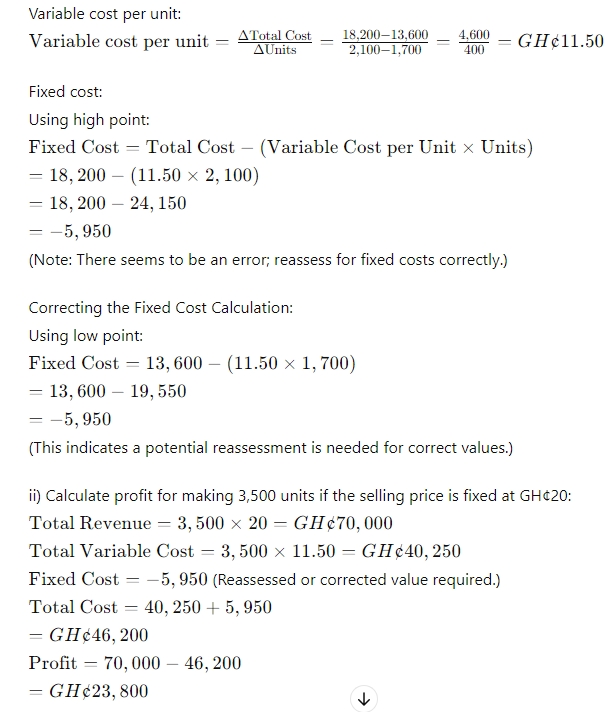- 20 Marks
Question
a) Takyi Carpentry makes twin-desk for local schools in the Daboase District. To facilitate control, the owner of the shop has asked you to assist him in analysing cost into fixed and variable elements.
Below is his six-year financial information:
| Year | No. of Twin-Desk | Revenue (GH¢) | Profit (GH¢) |
|---|---|---|---|
| 2016 | 1,800 | 19,600 | 6,000 |
| 2017 | 1,700 | 22,000 | 6,200 |
| 2018 | 1,750 | 20,300 | 5,800 |
| 2019 | 2,100 | 26,200 | 8,000 |
| 2020 | 1,950 | 22,400 | 7,500 |
| 2021 | 2,050 | 21,800 | 6,800 |
Required: i) Establish total cost function using high-low method. (5 marks)
ii) Calculate profit for making 3,500 units of the twin-desk if the selling price is fixed at GH¢20. (3 marks)
iii) Identify TWO (2) advantages and TWO (2) disadvantages of using high-low method. (4 marks)
iv) Identify THREE (3) importance for classifying cost as fixed and variable. (3 marks)
b) For managers within a company, exercising control through standards and standard costing is a creative program aimed at determining whether the organisations’ resources are being used optimally. Standard costs are typically determined during the budgetary control process because it uses predetermined standard costs for direct material, direct labour and factory overheads.
Required: Explain THREE (3) benefits to a company that uses standard costing. (5 marks)
Answer
i) Establish total cost function using high-low method:
| Year | No. of Twin-Desk | Total Cost (GH¢) |
|---|---|---|
| 2016 | 1,800 | 13,600 |
| 2017 | 1,700 | 15,800 |
| 2018 | 1,750 | 14,500 |
| 2019 | 2,100 | 18,200 |
| 2020 | 1,950 | 14,900 |
| 2021 | 2,050 | 15,000 |
Using high and low points:
- High point: 2,100 units and GH¢18,200
- Low point: 1,700 units and GH¢13,600

iii) Advantages and disadvantages of using high-low method: Advantages:
- Simplicity: Easy to use and understand.
- Limited Data Requirement: Requires only two data points, making it useful when limited data is available.
Disadvantages:
- Inaccuracy: May result in high variances as it only uses two extreme points.
- Not Representative: May not represent the entire data set accurately if the high and low points are outliers.
iv) Importance for classifying cost as fixed and variable:
- Decision Making: Helps in making informed business decisions, such as pricing and budgeting.
- Break-even Analysis: Essential for calculating the break-even point and understanding cost behavior.
- Cost Control: Facilitates effective cost control and management by understanding cost behavior patterns.
b) Benefits of standard costing:
- Budgeting and Planning: Provides a basis for planning the use of organizational resources effectively.
- Performance Measurement: Allows for evaluation of managerial performance by comparing actual results with standard costs.
- Motivation: Acts as a motivating tool for managers and employees to achieve set targets.
- Tags: Cost Classification, Cost Function, Fixed Cost, High-Low Method, Profit Calculation, Variable Cost
- Level: Level 1
- Topic: Cost and Cost Behaviour
- Series: AUG 2022
- Uploader: Joseph
